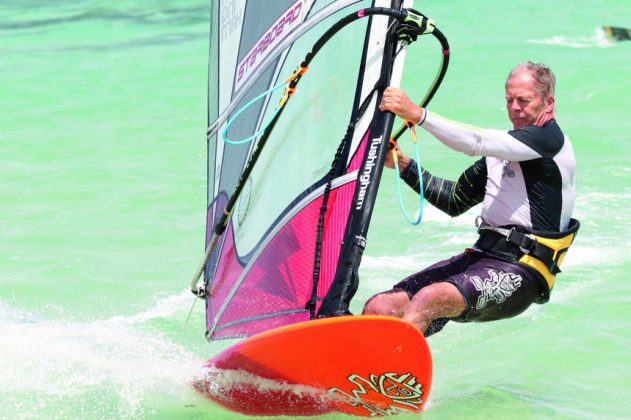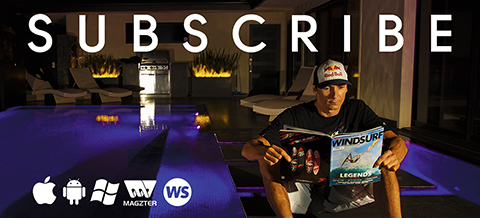WINNING THE MIND BATTLE
Words Peter Hart // Photos Hart Photography & Brett Kenny & John Carter
Originally published within the August ’16 edition.
Excuses abound when it comes to explaining a lack of progress – time on the water, wrong gear, lack of fitness etc. But in Harty’s considerable experience, the greatest problem usually lies between the ears.
Just back from a wave clinic, I spotted an email from Jess in my inbox. I opened it and joyfully anticipated a gushing torrent of praise. It had been a great week – gorgeous weather, a great mix of conditions, an especially well bonded group – and on top of that Jess had excelled. It was his first time in proper breaking waves. After a couple of lower lip wobbles, he grasped the nettle and by day 5 was busting through white water, doing an outside transition, catching swells (not a given in side-off winds) and following them down the line. Ok, he wasn’t drawing Polakow-esque lines, but was staying on the face and straightening up before they turned him over… and if he didn’t, he took the beating with a smile, walked up the beach and tried again.
The email did mention the joy of the general experience but he finished with: “I’m not sure if I learned anything but I definitely now have the confidence to go out in the waves.”
Was that a compliment or not? That’s the problem with email. You can’t see if there’s a wry smile, a twinkle in the eye or a furrowed brow. It sounded like an oxymoronic complaint along the lines of: “that lottery ticket I bought off you – it only coughed up a million quid.” The confidence to try something new is surely the greatest gift a coach can give and is the platform for endless improvement.
But I saw where he was coming from.
Jess, like the many involved in a technical sport, associates progress with the gathering of technical knowledge. It’s a contractual attitude to learning. Pay for lesson, get told what to do, do it and improve. In the early stages that sort of works. But then it doesn’t. As you strive for the upper levels of a dynamic sport, time is squeezed; more things need to happen at a faster pace. There’s no hope of listening to, digesting and then obeying a series of instructions.
With extra speed comes risk and fear and in windsurfing, the move up generally coincides with an ever more threatening environment and greater pressure.
What Jess was expecting from me was a Sergeant Major style list of orders. What he got were a few suggestions and a lot of questions. How was he feeling on the terrified-to-joyful scale? Could he see the wave as he rode it? Which bits did he feel happiest about?
It’s a tricky path for the coach to tread. The commercial approach is to give out incessantly because the constant one-way factual assault feels like value for money – but it isn’t.
With adults especially, when the effort to reward ratio starts to drop off, the best help they can get is often in relearning how to learn – and in changing their whole attitude towards themselves and skill acquisition.
But here’s the problem – I bet many of you are a bit turned off by all this ‘mental mastery’ stuff, having been forced to sit through one too many motivational talks from former sportsmen.
It passes a couple of hours on a dank Monday but what possible connection can there be between the pressure Johnny Wilkinson deals with lining up to drop a goal to win the rugby world cup and what you experience giving a departmental presentation or trying to crack a carve gybe? Quite a lot as it happens.
I have neither the desire nor the qualifications to descend into psychobabble. But from all the books and papers I’ve read by serious therapists, here are the non-technique based tips and strategies that have the potential to reboot the improving windsurfer.
“ When I was a lad, motivational speaking was limited to “Get stuck in you little git.” It may have had its place, but in a skill based sport, it didn’t exactly elicit the desired response ” ”
To be taught or to learn?
The book that made the greatest impression on me early on in my arrested development was Tim Gallwey’s ‘Inner Game.’ It was released in the mid 70s, well before the cult of sports science, and outlined a completely new approach to coaching and learning. So many of his ideas, gently ridiculed at the time in some quarters, have been expounded on and repackaged by many of today’s celebrity coaches.
Firstly he asserts that you can’t be taught a skill, you learn it through experience. It’s the coach’s job to encourage experimentation and then help you interpret and learn from those experiences.
I did an ‘Inner Skiing’ coaching course and throughout we were not allowed to instruct anybody to do anything. It was all “Tell me how much pressure you have coming through your toes …” and “What did that feel like as you straddled that sapling at 30 mph…” It was a little annoying at times, when all you wanted to scream was, “For heaven’s sake lean forward.” But the idea was to encourage the student to develop a feel for what’s going on. In equipment-led sports especially, that’s essential if you’re to make any meaningful adjustments.
Forget the numbers
We have a bit of a culture in windsurfing of doing things by numbers – literally and figuratively. Thanks to ever more detailed rigging instructions, we do as we’re told and when it doesn’t feel right, we cast our eyes to the skies in ignorant desperation. It’s not just the malaise of the mediocre. A many times British champion came up to me after a race where I’d had the temerity to overtake him and asked me where I’d had my mast-track for the upwind leg? (The Mistral Equipe we both used, had a one to ten scale on the track.) I told him ‘4.’ “Ah – that’s why!” He said as if I’d solved the mystery of the universe.
But he of all people should have known the track number was, by itself, an irrelevant piece of information. I was using a different rig and a different fin. I was 10 kg heavier with a very different stance. The sliding track is just one part of a complex tuning puzzle.
Upwind you’re feeling for that perfect balance where you’re getting just enough lift from fin and dagger to keep you planing on the rail at the right angle and where you feel the board knifing effortlessly through the chop. The track position controls that lift – forward to reduce it, back to increase it. But exactly where you have it depends on the amount of lift, which is determined by many other things like the size and rake of dagger and fin, the amount of downhaul and how fast you’re sailing and how high you’re trying to point. The answer to the track conundrum was to inch it back and forward until he balanced that lift and felt that slippery connection between board and water. But for a moment, the champ didn’t trust his own experience… and that’s another story.
When you’re helping someone with their set-up, the short term fix might be to bang on another inch of downhaul, open up their straps, put the boom up, lay your hands on their head and assure them all will now be fine. However, the long-term fix is to embark on a voyage of discovery. Put the boom to the top and bottom of the cut out; over and under tension both down and outhaul; put mastfoot at front and back of track; move harness lines apart and together. Now – go out, come back and then let’s talk about it.
I apologise if this sounds a bit too ‘Hippy’, but as we sail along, both board and rig are talking to us in their own language. They’re sending back loads of information through our hands, feet and harness, which a lot of the time we fail to clock or choose to ignore. But by messing around with the extremes of set-up you deepen the bank of experiences and potentially become more adept at self-analysis – because you know what an over-outhauled sail feels like.
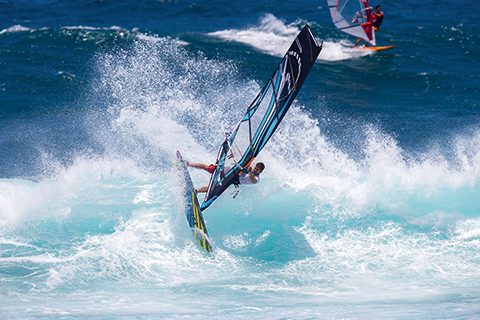
Find your inner child by embracing wipeouts and experimentation – few do it better than Ricardo Campello, seen here using all his childlike instincts and bravado to full effect at Ho’okipa. PHOTO John Carter
Finding the Inner Child
The most radical proposal of Gallweys’s Inner Game was that when we attempt a tricky task, we are two personalities. Self 1 is the cautious, critical, interfering adult, who approaches the challenge with a reasoning, interfering brain. Self 2 is the smiling, daring inner child who performs instinctively. Those who improve and perform best, manage to supress self 2 (more latterly described by psychologists as ‘the little voices’ or ‘the monkey on the back.’)
Forty years on Dave Aldred (Johnny Wilkinson’s kicking coach) takes the notion a step further in his book ‘The Pressure Principle.’ It’s not just the child’s instinct and bravado we want to emulate, but also their use of technical knowledge, and the notions of failure. He makes an interesting distinction between an adult learning to play golf and a child learning to skateboard. In one you have to hit a ball with a blade. In the other you have to balance at extreme angles, sometimes in the air, on a fast moving strip of wood with wobbly wheels. The latter appears a lot harder and yet a million tomes have been written about the golf swing and hardly any about how to skateboard – yet many kids learn to do it very well, very quickly. In a typical golf lesson you are bombarded with technical detail, the grip, the stance, the address, the take back … even before you’ve hit a ball. It’s an approach that sets you up to do lots wrong and … fail.
In skateboarding ‘wiping out’ is absolutely part of the learning process. It’s a badge of honour – it’s celebrated. If they fall, they don’t refer to the manual; they get up and try again making a few adjustments. They learn 100% through experimentation and feel.
In 2002 I was living next door to Ricardo Campello on Maui’s north shore. Ricardo was way ahead of the freestyle game at that stage. Natural talent? Yes – a bit – but boy did he put in the hours. Our houses were on Stable Road, at a spot where there was no public access so the water was empty. Most evenings he was out with his mate and training partner Diony Guadignino just … trying stuff. The Spock was the move of the moment and they were looking to take it different places.
During one session, they were trying to chuck a mid air duck gybe into it, later to be called the ‘Diabalo.’ They had NO idea what would happen. One would have a go. The other would watch. As one crashed horribly yet again, the other would ‘whoop’ wild encouragement. They’d have a quick chat and then go again. Sure enough after 2 hours and 100 bloody curdling wipeouts, one of them nailed it. I used to go out and join them and found it the most fertile, sometimes painful but always fun learning environment. Here’s why.
No fear of failure.
Fear of failure is one of the greatest learning inhibitors. Think of a football team trying not to lose compared to one trying to win – the former tight and defensive; the latter energetic and ambitious. Look at a kid learning to speak – loads of babble and then out comes ‘tractor’ to much parental applause. The babble wasn’t failing, it was just interesting research towards a greater goal.
During those evening sessions there was no thought of losing or failing – just desire to improve. Personally the times I sail worse are when I’m trying to preserve my precious reputation. Fear of looking anything but flawless in front of a critical public makes you shrink into your comfort zone and only do the things you can do.
So sail with people who are trying stuff too. Jess, our hero at the beginning of this piece, gained his confidence from practising in a non-judgemental environment where everyone was crashing and enjoying each other’s successes.
Concept of failure
For some, failure is any attempt which isn’t 100% successful – which is why, I guess, golfers always look miserable. Turn it round by identifying realistic goals. As you go for that first duck gybe, what would be a reasonable outcome? Perhaps just letting go of the front hand, then maybe a feeling of crossing the hands. The first time you see the new side of the boom under the foot of the sail is a cause for celebration.
Embrace the UGLY ZONE
Anders Ericsson is the psychologist who came up with the 10,000 hour rule – the amount of time it takes the expert sportsman, musician or artist to attain excellence. It’s 3 hours a day for a decade. It’s been quoted by many, most notably by Malcom Gladwell in his book ‘Outliers’. But the bit of his research that often isn’t quoted is: “You don’t just repeat what you know but instead constantly seek to stretch yourself, which involves … repeated failure and a dogged ability to keep dusting yourself down again.”
Dave Aldred refers to this as the ‘ugly zone.’ It’s that initial learning phase where your execution does not match your intention; that time plugging away at a new skill before the various elements become instinctive. He asserts that you cannot learn a complex skill unless you go there (Ricardo and Diony spent a LOT of time there). It’s the crash and burn zone. Crashing and burning itself is not a guarantee of eventual success. It’s how you deal with it mentally, whether you enjoy it and whether you learn from it.
One of the key factors in controlling your temperament in the ‘ugly zone’ is your use of language.
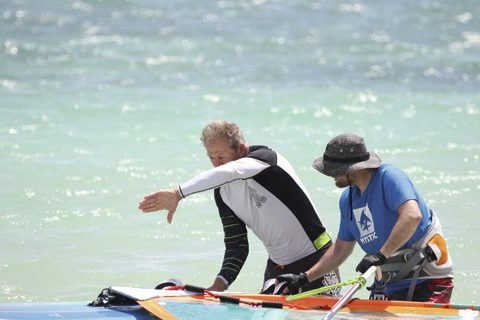
The coach can aid or befuddle depending on the content and register of his advice. Whether being coached or self-coaching, less is definitely more when it comes to technical instructions. And it’s far better to be told WHAT to do rather than what NOT to do.
The Power of Words
Ask any group of people whether they’re influenced by advertising and they’ll surely assert that they are immune to the seductive words of the devious corporations. But research would suggest just the opposite. In an experiment by US psychologist John Bargh, two sets of New York students were given scrambled sentence tests – random words which they had to reorder. Subtly imbedded in the sentences of the first group were words such as ‘aggressive’, ‘bold’, ‘rude’ and ‘intrude’. Whereas the other group had words such as ‘respect’, ‘polite’, ‘yield’ and ‘considerate’. At the end of the test, they were asked to hand their papers into the office one by one. At the office, they were kept waiting by the clerk who was deep in conversation with a demanding student (actor in this case). Those who had been given aggressive words interrupted after 5 minutes or less; whereas 82% of those given the passive words didn’t interrupt at all.
Language has a deep and lasting influence on our mood. If we think of words in a teaching context we think of teachers and coaches – but in windsurfing we spend most of the time out of earshot of instructors and what we have running in our head before, during and after the event is a relentless self-commentary. Changing the register of that commentary can change your mood and attitude.
Entering a gybe:
“I hope I don’t trip a rail and smash into the mast.”
or
“I love the feeling of the rail biting and that acceleration.”
Before a waterstart:
“I hate it when the sail backwinds and I get trapped under it.”
or
“I wonder if I can beat my PB and get up and out in under 5 secs.”
Dipping into a first loop attempt:
“This is where I catapult onto the rig and have to take a month off work.”
or
“Wheeeeeeeeeeeeeee!!!!”
In the pub after a gybe session.
“I blew 7 out of 10 gybes.”
or
“I did 3 really good ones.”
I nearly got through to the end of this piece without mentioning the dreaded ‘power of positive thinking’. That’s sort of what this is about but words can go a lot further than offer a self-congratulatory pat on the back.
When we’re learning a new skill or thanks to a pressure situation (a race, a lot of wind, big waves) are struggling with one we can already do, we tend to get anxious and revert to the cognitive phase. We over-think and issue a series of conflicting commands to our confused limbs, which know what to do if only we would let them.
In golf, Tim Gallwey (The Inner Game) gives those struggling with their swing a simple aim – to hit the ball and a simple verbal cue – at the top of the swing they have to say ‘back’ and as they make contact they have to say ‘hit.’ I’ve tried it – it’s astonishing.
What we need are personal words to silence the jabbering Self 1 personality.
Entering a loop with thoughts of god-knows-what, I get people to shout ‘look back’. It’s something they’ve been meaning to do forever but the simple verbal command often triggers the right physical response.
Shout ‘jump’ as you jump off a wave. It may make you lift and extend rather than squash.
Shout ‘punch’ as you enter a gybe, which may make you extend the front arm and project forward, rather than leaning back and choking the rig.
And a word about coaches and teachers here… they can use a lot of words and they’re not always the right ones.
As a child, or maybe as an adult, someone in authority has surely pinned you with the immortal phrase: “I’ve told you a hundred times to …”. With your cool head on, your reply should have been: “Well if you’ve told me 100 times and I’m still not doing it, maybe the message is wrong! So change the message!”.
Advice and words need to be specific to you. You may well have been told to lean forward in the carve gybe. It’s reasonable but very vague and you’re not really sure what’s expected. Tell 10 people to lean forward and they’ll all do something different. Some may drop their head, some may bend at the waist. What may work better is: “bend the ankles” or “press on your front toe”.
Get your coach to keep changing the command until it elicits the right reflex.
And perhaps even more important is when you’re self-teaching or being coached, make sure you’re being told what to do, not what NOT to do.
You’re told “NOT to spin out as you go out through the impact zone or the next set will crush you.” What are you thinking about? Getting crushed of course. The negative instruction plants the negative seed. “Imagine you’re in a slalom race and the finish line is 100m offshore – go for it!” – might get a better reaction.
“ Did you know that in Justin Bieber’s song, ‘Never say never,’ he says ‘never’ 67 times? ”
Fear and Posture
Probably the best quote in sports psychology was famously uttered by Jack Donohue, a basketball coach from the US. When it came to anxiety under pressure, he said that you can never get rid of the butterflies, but you can get them to fly in formation.
When the butterflies fly together, anxiety means excitement, adrenaline = increased alertness and performance; when they don’t, you recede into panicky, reactive, ‘tunnel vision’, ‘flight or fight’ mode.
So how do we train our butterflies?
In that last section we saw how the mind (words in that case) can control the body. But in pressure situations it can also work the other way round – you can get your body to control the mind. When training elite athletes, Dave Aldred (The Pressure Principle) talks endlessly about them assuming ‘the Command Position’.
It basically means standing tall, making yourself big, making like a pillar and taking up the strongest possible stance. It’s the posture you assume when you know you can’t fail. It’s Johnny Wilkinson lining up a kick at goal.
Compare that to being stuck in a traffic jam late for the most important meeting of your life. You’re hunched forward, small, tight as a drum, knuckles white, hands gripping the wheel in terminal frustration.
I immediately think of a speed course and record holder Antoine Albeau. No matter if he’s blitzing at 52 knots on the edge of the fastest wipe of all time, he remains tall and big (he’s big anyway … but he makes himself even bigger) and strangely serene. Compare that to a division 2 speedster less confident about the outcome. They’re small, squat in a defensive, closed, ‘stuck-in-traffic jam’ posture.
Yes, it’s all under the general heading of body language. Change the language and the mind may listen and understand.
The trick is to learn to recognise your ‘fight or flight’ posture. Changing the posture won’t change the weather, the size of the shorebreak or the general situation – but it can change your attitude to it.
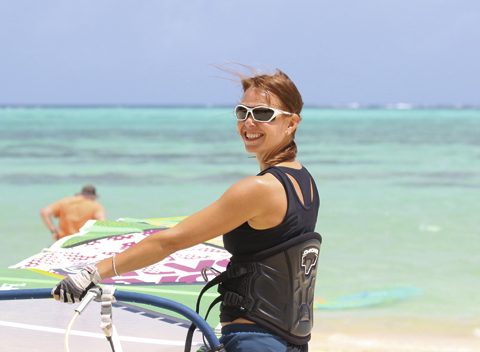
The body can control the mind. Scientists have discovered that the acts of standing tall and smiling, even though they might not reflect your immediate emotions, can bring you out of ‘fight or flight’ mode and elicit a positive approach to the task.
Avoiding the sensory shutdown
Ned came back in after a session in the Irish waves and in his hilarious Irish way described how he completely lost it trying to waterstart out the back. “I don’t know what the fff I was doing (Ned swears a lot)! I was like an Octopus with 10 arms after 20 cans of Red Bull, thrashing all over the place! So I had a little word with myself, calmed down, had a rest and then all was dandy.” For a brief moment, Ned had experienced ‘sensory shutdown’ – as indeed we all have. ‘Sensory shutdown’ kicks in when your heart rate, either though physical exhaustion or mental stress, reaches about 175 bpm. It’s then that we go into ‘fight or flight’ mode and our decision making, our ability to listen, see and perform fine motor skills, are impaired.
Two coppers are chasing an armed suspect, one is a trained 800-metre runner, the other is on a diet of muffins and coke. When they catch up with him, make sure you take the gun off the panting muffin-eater.
If you want to see ‘sensory shutdown’ in action, watch a novice wave-sailor fighting a shorebreak. Getting caught in a shorebreak is the most exhausting all-muscle sport known to man. He stares at it for a while – the perfect way to raise the anxiety levels and heart rate. He makes a charge – does a running beachstart, not bad, but gets wiped by the first dumper. He makes a dive for the kit, wrestles it into position, jumps on again, badly this time and spins straight into wind, only to repeat the process. Thereafter every attempt makes less and less sense as his heart pumps out of his chest and he fights the tiger in front of him rather than make smart tactical decisions about the whole situation.
When I’m coaching in the shorebreak, the golden rule is, if you get wiped close in, drag the kit back out, rest, reboot the hard drive and when calm, try again.
Anxiety and high stress interferes with your rehearsed processes. When golfers are too hyped up or exhausted they try and hit the ball too hard. In the same state a carve gyber will stamp on the rail rather than easing onto it and gradually increasing the pressure.
Taking frequent rests, breathing, getting the heart rate down, having a positive chat and resetting the goals are free, easy and guaranteed ways to make a good session better.
Jess, without knowing it, learned all that during his wave week and now has the confidence to go and give it a lash. He just has to close his ears to loads of ‘how to …’ teccy stuff – and probably stop reading articles like this one!
Harty has a fabulous new website www.peter-hart.com revealing news of everything windsurfing including spaces on up and coming clinics. Email him for his monthly newsletter on [email protected] or like his Peter Hart Masterclass page.


